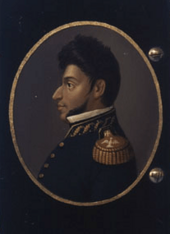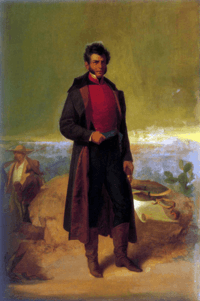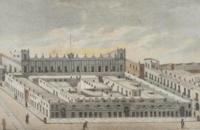Vicente Guerrero facts for kids
Quick facts for kids Vicente Guerrero |
|
|---|---|

A half-length, posthumous portrait by Anacleto Escutia (1850)
|
|
| 2nd President of Mexico | |
| In office April 1, 1829 – December 17, 1829 |
|
| Vice President | Anastasio Bustamante |
| Preceded by | Guadalupe Victoria |
| Succeeded by | José María Bocanegra |
| Minister of War and Navy | |
| In office December 8, 1828 – December 25, 1828 |
|
| President | Guadalupe Victoria |
| Preceded by | José Castro |
| Succeeded by | Francisco Moctezuma |
| Member of the Supreme Executive Power | |
| In office April 1, 1823 – October 10, 1824 |
|
| Preceded by | Constitutional Monarchy Agustín I |
| Succeeded by | Federal Republic Guadalupe Victoria |
| Personal details | |
| Born | Vicente Ramón Guerrero August 10, 1782 (baptism date) Tixtla, Kingdom of Mexico, Viceroyalty of New Spain |
| Died | February 14, 1831 (aged 48) Cuilapan, Oaxaca, Mexico |
| Cause of death | Execution by firing squad |
| Political party | Liberal Party |
| Spouse(s) | María Guadalupe Hernández |
| Children | 2 |
| Profession | Military Officer Politician |
| Signature |  |
| Military service | |
| Allegiance | |
| Service/branch | Mexican Army |
| Years of service | 1810–1821 |
| Rank | General Lieutenant colonel Captain |
| Commands | Mexican War of Independence |
| Battles/wars | Battle of El Veladero Siege of Cuautla Battle of Izúcar Siege of Huajuapan de León Battle of Zitlala Capture of Oaxaca Siege of Acapulco |
Vicente Ramón Guerrero (baptized August 10, 1782 – February 14, 1831) was a Mexican soldier and important leader. He became the second president of Mexico. Guerrero was a key general who fought against Spain during the Mexican War of Independence.
During his time as president, he made a big change by ending slavery in Mexico. Later, his Vice-President, Anastasio Bustamante, led a rebellion that removed Guerrero from power.
Contents
Early Life and Family
Vicente Guerrero was born in Tixtla, a town about 100 kilometers from the port of Acapulco. This was in the Sierra Madre del Sur mountains. His parents were María Guadalupe Rodríguez Saldaña and Juan Pedro Guerrero. His father's family were landowners, farmers, and traders. They also had connections to the Spanish army and made guns.
When he was young, Vicente worked in his father's business. They used mules to transport goods, which was a good business back then. His travels helped him learn about the idea of independence for Mexico. People have different ideas about Guerrero's background. Some say he was Indigenous, mixed-race (mestizo), or African. No pictures of him were made while he was alive. So, later portraits might not be fully accurate. Another rebel leader, José María Morelos, described him as a "young man with tanned skin, tall and strong, with an aquiline nose, bright eyes, and big sideburns."
Vicente's father, Juan Pedro, supported Spanish rule. But Vicente was against the Spanish government. When his father asked him to give his sword to the Spanish viceroy as a sign of loyalty, Vicente refused. He famously said, "The will of my father is sacred to me, but my Fatherland is first." This phrase, "Mi patria es primero" (My homeland comes first), is now the motto of the Mexican state of Guerrero. This state was named in his honor.
In December 1810, Guerrero joined José María Morelos's rebel army. He married María Guadalupe Hernández. Their daughter, María Dolores Guerrero Hernández, later married Mariano Riva Palacio. He was the lawyer for Maximilian I of Mexico.
Fighting for Independence
In 1810, Guerrero joined the fight against Spain. He first served under the priest José María Morelos. Guerrero was working as a gunsmith in Tixtla when the Mexican War of Independence began. He joined the rebellion in November 1810. He was part of a group that Morelos organized to fight in southern Mexico.
Guerrero showed great bravery in the Battle of Izúcar in February 1812. By November 1812, when rebels took Oaxaca, he had become a lieutenant colonel. Morelos's forces had some early wins, but then faced difficulties. Morelos himself was captured and executed in December 1815. Guerrero then joined forces with Guadalupe Victoria and Isidoro Montes de Oca. He became the "Commander in Chief" of the rebel troops.
In 1816, the Spanish government offered to forgive rebels if they surrendered. Guerrero's father even asked him to give up, but Guerrero refused. He was the only major rebel leader still fighting. He kept the rebellion alive through a long campaign of guerrilla warfare. He won battles in areas of southern Mexico that he knew very well.
The Spanish government sent Agustín de Iturbide to defeat Guerrero's forces. But Guerrero won against Iturbide. Iturbide then realized that neither side could win easily. Guerrero asked Iturbide to stop fighting for Spain and join the independence movement. Things had changed in Spain in 1820. Spanish liberals had removed King Ferdinand VII and brought back a liberal constitution. This made conservatives in Mexico, including the Catholic Church, think that staying loyal to Spain was not good for them. They decided to support independence to keep their power.
Guerrero's idea to join forces for independence worked. Guerrero and Iturbide formed an alliance under the Plan de Iguala. Their armies joined together to become the Army of the Three Guarantees.
The Plan of Iguala
The Plan of Iguala declared Mexico's independence. It called for a constitutional monarchy (a king with a constitution) and said the Roman Catholic Church would remain important. It also ended the formal casta system, which was a way of classifying people by race. A key part of the plan (Clause 12) said: "All inhabitants... without distinction of their European, African or Indian origins are citizens... with full freedom to pursue their livelihoods according to their merits and virtues." This meant everyone was equal. The Army of the Three Guarantees marched into Mexico City in triumph on September 27, 1821.
Iturbide was then declared Emperor of Mexico by the Mexican Congress. In January 1823, Guerrero, along with Nicolás Bravo, rebelled against Iturbide. They went back to southern Mexico to start another rebellion. Some say this was because the emperor had stopped their careers. Their goal was to bring back the original Congress. Guerrero and Bravo were defeated by Iturbide's forces less than a month later. When Iturbide's empire fell in 1823, Guerrero was named one of the three leaders of the new government.
The 1828 Presidential Election
Guerrero believed in liberal ideas. He was active in the York Rite Masons, a group formed in Mexico after independence. This group was popular with many Mexicans. The Scottish Rite Masons, another group, were more conservative. Since there were no political parties yet, these Mason groups acted like political organizations. Guerrero had many followers among the Yorkinos in cities. They helped him during the 1828 election.
In 1828, the first president, Guadalupe Victoria, finished his four-year term. The election to choose the next president was very competitive. Guerrero's supporters were liberal federalists. General Gómez Pedraza won the election in September 1828. Guerrero came in second, and Anastasio Bustamante was third. Gómez Pedraza was supported by a group called the "Impartials."
The U.S. diplomat in Mexico, Joel Roberts Poinsett, supported Guerrero. He wrote that Guerrero was "uneducated, but possesses excellent natural talents, combined with great decision of character and undaunted courage."
Guerrero himself did not write much, but some of his speeches remain. He once said, "A free state protects the arts, industry, science and trade; and the only prizes virtue and merit... let's do this in such a way that we will not be a burden for the nation, just the opposite, in a way that we will satisfy her needs, helping her to support her charge and giving relief to the distraught of humanity: with this we will also achieve abundant wealth for the nation, making her prosper in all aspects."
Two weeks after the election, Antonio López de Santa Anna started a rebellion to support Guerrero. Santa Anna was a powerful general and governor of Veracruz. He wanted Gómez Pedraza's election to be cancelled and Guerrero to be declared president.
In November 1828, in Mexico City, Guerrero's supporters took control of a former prison that was now an armory. Days of fighting broke out in the capital. Gómez Pedraza, who had not yet become president, resigned and went to England. With his resignation, there was a lot of disorder. On December 4, 1828, a riot happened in the Zócalo, the main square. The Parián market, where expensive goods were sold, was looted. Order was restored quickly, but rich people in the capital were worried about the violence.
Because Gómez Pedraza resigned, and Santa Anna's forces and the powerful politician Lorenzo de Zavala supported Guerrero, Guerrero became president. Guerrero took office with Bustamante, a conservative, as his vice president. One historian said that Guerrero became president because of a "mutiny." He had only a small amount of support.
Guerrero's Presidency
| Government of Vicente Guerrero | ||
|---|---|---|
| Office | Name | Term |
| Foreign Affairs | José María Bocanegra | Apr. 1, 1829–Nov. 2, 1829 |
| Agustín Viesca | Nov. 3, 1829–Dec. 18, 1829 | |
| Justice | Joaquín de Iturbide | Apr. 1, 1829–Apr. 7, 1829 |
| José Manuel de Herrera | Apr. 8, 1829–Dec. 18, 1829 | |
| Finance | Bernardo González Angulo | Apr. 1, 1829–Apr. 13, 1829 |
| Francisco Moctezuma | Apr. 14, 1829–Apr. 17, 1829 | |
| Lorenzo de Zavala | Apr. 18, 1829–Nov. 2, 1829 | |
| José María Bocanegra | Nov. 3, 1829–Dec. 17, 1829 | |
| War | Francisco Moctezuma | Apr. 1, 1829–Dec. 18, 1829 |
Guerrero became president on April 1, 1829. His vice president was the conservative Anastasio Bustamante. For some of Guerrero's supporters, it was a big deal that a mixed-race man from outside the capital became president. They saw it as a step towards "the reconquest of this land by its legitimate owners." Some wealthy white Mexicans were worried about Guerrero being president.
Guerrero chose a cabinet of liberals. But his government faced serious problems. The national treasury was empty. Spain still did not recognize Mexico's independence and threatened to reconquer it.
A very important thing Guerrero did as president was to completely end slavery in Mexico. The slave trade had already been banned by Spain in 1818. Mexico's new government had confirmed this ban in 1824. Some Mexican states had also ended slavery. But on September 16, 1829, Guerrero's government declared that slavery was completely abolished across the entire nation. At this time, slavery was not common in most of Mexico. Only the state of Coahuila y Tejas was greatly affected. This was because slave owners from the United States had moved there.
Guerrero also wanted public schools, land reforms, and to develop industry and trade. As president, he supported people who were treated unfairly because of their race or economic situation.
During Guerrero's presidency, the Spanish tried to reconquer Mexico. But they were defeated at the Battle of Tampico.
Downfall and Execution
Guerrero was removed from power by a rebellion led by Vice-President Anastasio Bustamante. This rebellion started on December 4, 1829. Guerrero left the capital to fight in the south. But he was removed by the Mexico City army on December 17, 1829. Guerrero went back to the southern region where he had fought during the war for independence.
There was fierce fighting between Guerrero and his opponent in the region, Nicolás Bravo. Bravo had been a Spanish officer, while Guerrero was a hero of the independence movement. Bravo controlled the highlands, including Guerrero's hometown of Tixtla. Guerrero was strong in the hot coastal areas, where many mixed-race people had joined the fight for independence.
The conflict in the south continued throughout 1830. Meanwhile, conservatives gained more power in Mexico City.
The war in the south ended in a shocking way. Guerrero was captured in Acapulco because of a betrayal. He was executed a month later. Guerrero controlled Acapulco, Mexico's main Pacific coast port. An Italian ship captain named Francisco Picaluga offered the conservative government in Mexico City a deal. He would trick Guerrero onto his ship and capture him for 50,000 pesos. This was a huge amount of money at the time.
Picaluga invited Guerrero onto his ship for a meal on January 14, 1831. Guerrero and a few of his helpers were taken prisoner. Picaluga sailed to the port of Huatulco. There, Guerrero was handed over to federal troops. Guerrero was taken to Oaxaca City and quickly put on trial by a military court.
Many conservatives and some state governments were happy about his capture. However, the states of Zacatecas and Jalisco tried to stop Guerrero's execution. The government's 50,000 peso payment to Picaluga became known to the public through liberal newspapers. Despite many pleas to save his life, Guerrero was executed by a firing squad in Cuilapam on February 14, 1831.
His death did end the rebellion in southern Mexico. But the politicians involved in his execution faced lasting damage to their reputations. Many Mexicans saw Guerrero as the "martyr of Cuilapam." A liberal newspaper called his execution "judicial murder." The two conservative cabinet members most blamed for Guerrero's execution, Lucas Alamán and José Antonio Facio, spent the rest of their lives defending themselves. They were accused of arranging Guerrero's capture.
Historian Jan Bazant wondered why Guerrero was executed instead of being sent away, like Iturbide or Antonio López de Santa Anna. He suggested that because Guerrero was of mixed race, his execution might have been a warning. It might have been a message to people considered "socially and ethnically inferior" not to try to become president.
Honors were given to Guerrero's family members who were still alive. His widow received a pension. In 1842, Vicente Guerrero's remains were moved to Mexico City. He is remembered for his ideas about equal civil rights for all Mexican citizens. He has been called the "greatest man of color" to ever live.
Legacy
Guerrero is a Mexican national hero. The state of Guerrero is named in his honor. Several towns in Mexico are also named after this famous general. These include Vicente Guerrero in Durango and Vicente Guerrero in Baja California. There is also the Colonia Guerrero neighborhood.
Images for kids
-
Statue in honor of Vicente Guerrero in Nuevo Laredo.
See also
 In Spanish: Vicente Guerrero para niños
In Spanish: Vicente Guerrero para niños
- Filipino immigration to Mexico
- Gaspar Yanga
- History of Mexico
- José María Larios
- Liberalism in Mexico
- List of presidents of Mexico
- List of wars involving Mexico








